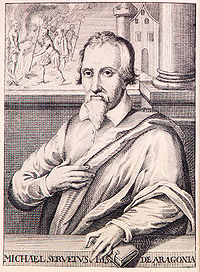September 29: Michael Servetus
Michael Servetus (1511)
It was on this date, September 29, 1511,* that the Spanish cleric Miguel Serveto, known by his Latinized name, Michael Servetus, was born in Villanueva. Recognizing an incipient intellect, at the age of 13, his father, a Roman Catholic cleric, sent his son to study at the University of Zaragoza/Lerida. It developed that among his other talents, Servetus was a gifted linguist and excelled in the study of Latin, Greek and Hebrew, enabling him (at age 15) to read the entire Bible in its original languages while in the service of a Franciscan friar. Servetus also studied law at Toulouse and medicine in Paris.
But by 1530 Servetus bought into the theology of the 4th century theologian Arius, which denies the Trinity because it is found nowhere in the Bible. Denying the Trinity (Arianism) necessarily means denying the divinity of Jesus, who instead of being one with God was merely like God.** The Greek words describing this doctrinal difference varied by a single vowel – homoiousios vs. homoousios, perhaps giving rise to the venerable expression, "one iota of difference" – but, in the time of Servetus, the consequences of buying the wrong vowel could be deadly.
Taking the nom de plume Michel de Villeneuve, Servetus published anyway: in July 1531 he published De trinitatis erroribus; in 1532 De trinitate and De Iustitia regni Christi. He believed he could avoid persecution by the Church. After 1536, Servetus practiced medicine for about fifteen years near Lyon and also published two works on Ptolemy's Geography, in which Palestine and Judea were spoken of, not as "a land flowing with milk and honey," as the Bible says, but, correctly, as barren and inhospitable.
In 1553 Servetus published another Arianist religious work entitled Christianismi restitutio (The Restoration of Christianity). In 1546, he published the medical discovery for which he is remembered today – about the pulmonary circulation of blood through the lungs.
As brilliant as he was, Servetus could not countervail the political correctness, and doctrinal correctness, of his time. In April 1553 he was arrested and imprisoned in Vienne, "Convicted of heresy by the Roman Catholic authorities." He escaped in June, intending to hide out in Italy, but Servetus passed through Geneva, where John Calvin, who had secretly gotten him arrested in Vienne, was waiting for him. On 13 August 1553 Servetus attended a sermon by Calvin,. but was recognized and arrested. He was thrown into "... an atrocious dungeon with no light or heat, little food, and no sanitary facilities."
He was charged with being an "obstinate heretic" by a theocrat who had to prove his sovereignty over Geneva by brutalizing doubters of dogma. Seven years earlier, Calvin had threatened execution if he ever showed his face in Geneva, so the fate of Servetus was never in doubt.
On 27 October 1553, sentence was carried out. William Osler described it thus:
[I]t is said that he looked like the Christ in whose name he was bound. Around his waist were tied a large bundle of manuscript and a thick octavo printed book. The torch was applied, and as the flames spread to the straw and sulphur and flashed in his eyes, there was a piercing cry that struck terror into the hearts of the bystanders. The faggots were green, the burning was slow, and it was long before in a last agony he cried again, "Jesu, thou Son of the eternal God, have mercy on me!"†
Phillip Melanchthon wrote to Calvin to congratulate him: "The Church, both now and in all generations, owes and will owe you a debt of gratitude." A few months later, this time in effigy, Servetus was again executed by the Inquisition in France. Had he been more circumspect, or less brilliant, he might have had a long life. Though a believer, Servetus had dared to doubt the prevailing orthodoxy – he had expressed an opinion – and he had been killed for it. He was only 42 years old.
* Some sources, including Servetus himself, put the year of his birth at 1509.
** Jesus having one substance with God is Greek ‘ομουσιος; his having distinct but similar substance is Greek ‘ομοιυσιος. Arianism was condemned by the Council of Nicea (which formulated the Nicene Creed) in 325, but flourished, anyway, until brutally suppressed in the eighth century. Thereafter it survived in isolated areas or went underground.
† Sir William Osler (1849-1919), Michael Servetus, London, Oxford University Press, 1909, Page 35. Osler (1849-1919), a Canadian-born physician, historian and a freethinker, described it as follows:
...Shortly after twelve o'clock, a procession started from the town-hall of Geneva – the chief magistrates of the city, the clergy in their robes, the Lieutenant Criminel and other officers on horseback, a guard of mounted archers, the citizens, with a motley crowd of followers, and in their midst, with arms bound, in shabby, dirty clothes, walked a man of middle age, whose intellectual face bore the marks of long suffering. Passing along the rue St. Antoine through the gate of the same name, the cortege took its way towards the Golgotha of the city.
Once outside the walls a superb sight broke on their view: in the distance the blue waters and enchanting shores of Lake Geneva, to the west and north the immense amphitheater of the Jura, with its snow-capped mountains, and to the south and west the lovely valley of the Rhone; but we may well think that few eyes were turned away from the central figure of that sad procession.
By his side, in earnest entreaty, walked the aged pastor, Farel, who had devoted a long and useful life to the service of his fellow citizens. Mounting the hill, the field of Champel was reached, and here on sight eminence was the fateful stake, with dangling chains and heaping bundles of faggots. At this sight the poor victim prostrated himself on the ground in prayer.
In reply to the exhortation of the clergyman for a specific confession of faith, there was the cry, "Misericordia, misericordia! Jesu, thou Son of the eternal God, have compassion upon me!" Bound to the stake by the iron chains, with a chaplet of straw and green twigs covered with sulphur on his head, with long dark face, it is said that he looked like the Christ in whose name he was bound. Around his waist were tied a large bundle of manuscript and a thick octavo printed book.
The torch was applied, and as the flames spread to the straw and sulphur and flashed in his eyes, there was a piercing cry that struck terror into the hearts of the bystanders. The faggots were green, the burning was slow, and it was long before in a last agony he cried again, "Jesu, thou Son of the eternal God, have mercy on me!" Thus died in his forty-fourth year, Michael Servetus Villanovanus, physician, physiologist, and heretic.
Strange, is it not, that could he have cried, "Jesu, thou Eternal Son of God!" even at this last moment, the chains would have been unwound, the chaplet removed, and the faggots scattered; but he remained faithful unto death to what he believed was the Truth as revealed in the Bible.
Originally published September 2003 by Ronald Bruce Meyer.



